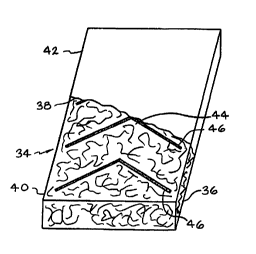Note: Claims are shown in the official language in which they were submitted.
WHAT IS CLAIMED IS:
1. An insulation assembly (10, 22, 34, 72, 86, 100) comprising an elongated
batt (16, 26, 36, 76, 104) of fibrous insulation material having a top (20,
32, 42) end and a
bottom (18, 30, 40, 78, 94, 106) end, and a facing secured on a major surface
(44, 116),
characterized in that the facing being secured to the major surface (44, 116)
by a series of
spaced apart adhesive ribbons (14, 24, 46, 74, 88, 102), wherein the adhesive
ribbons (14,
24, 46, 74, 88, 102) are oriented generally transversely of the insulation
assembly (10, 22,
34, 72, 86, 100), and are nonlinear in a generally downwardly-oriented concave
shape.
2. The insulation assembly (10, 22, 34, 72, 86, 100) of claim 1 wherein the
ribbons (14, 24, 46, 74, 88, 102) include opposed left (52, 80, 108) and right
(54, 82, 110)
portions.
3. The insulation assembly (10, 22, 34, 72, 86, 100) of claim 2 in which the
left (52, 80, 108) and right (54, 82, 110) portions are oriented along
generally straight
lines.
4. The insulation assembly (10, 22, 34, 72, 86, 100) of claim 3 in which the
left (52, 80, 108) and right (54, 82, 110) portions are generally oriented at
an angle within
the range of from about 120 degrees to about 170 degrees with respect to each
other.
5. The insulation assembly (10, 22, 34, 72, 86, 100) of claim 2 in which the
left (52, 80, 108) and right (54, 82, 110) hand portions are connected to each
other.
6. The insulation assembly (10, 22, 34, 72, 86, 100) of claim 2 in which the
left (52, 80, 108) and right (54, 82, 110) portions are curved lines.
7. The insulation assembly (10, 22, 34, 72, 86, 100) of claim 6 in which the
left (52, 80, 108) and right (54, 82, 110) hand portions are connected to each
other.
8. The insulation assembly (10, 22, 34, 72, 86, 100) of claim 1 in which the
ribbons are symmetrical with respect to a longitudinal axis (96) of the
insulation assembly
(10, 22, 34, 72, 86, 100).
9. The insulation assembly (10, 22, 34, 72, 86, 100) of any of the earlier
claims in which the adhesive ribbons (14, 24, 46, 74, 88, 102) extend from
edge to edge of
the major face of the batt (16, 26, 36, 76, 104).
10. An insulation assembly (10, 22, 34, 72, 86, 100) of any of the earlier
claims comprising an elongated batt (16, 26, 36, 76, 104) of fibrous
insulation material
having a top (20, 32, 42) end and a bottom (18, 30, 40, 78, 94, 106) end, and
a facing
9
secured on a major surface (44, 116), the facing being secured to the major
surface (44,
116) by a series of spaced apart adhesive ribbons (14, 24, 46, 74, 88, 102),
wherein the
adhesive ribbons (14, 24, 46, 74, 88, 102) are oriented generally transversely
of the
insulation assembly (10, 22, 34, 72, 86, 100), are nonlinear in a generally
downwardly-oriented concave shape, and include opposed left (52, 80, 108) and
right (54, 82, 110)
portions connected together and oriented along generally straight lines.
